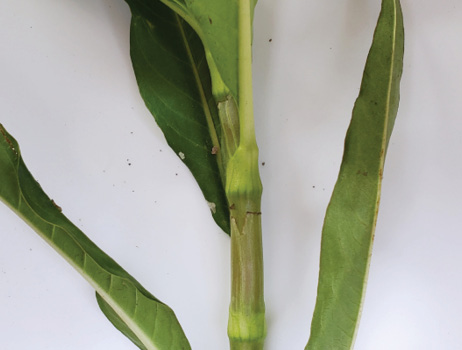Smartweed | Polygonum and Persicaria spp.
Emergent | Native and Non-Native


meet stem on knotweed.

Polygonum is composed of two groups, smartweed and knotweed, which are both common plants in Mississippi’s terrestrial and aquatic settings. However, most Polygonum species prefer moist-soil habitats.
Polygonum is an erect plant that has simple, alternating, sword-shaped leaves of glossy green. Each leaf has a central vein and secondary veins that extend from the central vein at roughly a 45-degree angle. Where the leaf stalk joins the stem, there are distinctive enlarged joints, or knots, from which the knotweed name is derived. There is also a membrane around the stem above each node (called an ocrea) that is distinctive to plants of this genus.
This species can flower between May and November. Depending on the variety, the blooms range in color from white to pink to green. The two groups can sometimes be differentiated by the flower type: smartweed has a terminal spike of flowers, while knotweed has a cluster of flowers in the leaf axil. However, it is typically unnecessary for the pond owner to distinguish between the two.
Management Value
Polygonum is a very important plant to many species of wildlife. It attracts pollinators including bees and butterflies. The seeds are a critical part of the diet of waterfowl, upland game birds, songbirds, and small mammals. The plants are browsed by deer and other species.
Dense stands of Polygonum species provide nesting and cover habitat for birds and mammals, and submerged plants provide fish habitat. Humans have historically used it for dyeing fabric and in holistic medicine. The seeds are also edible.
Polygonum establishment and growth is encouraged in moist-soil habitats that are flooded for waterfowl, as it attracts migrating birds. However, it is not typically encouraged in recreational pond management, as it spreads quickly and interferes with pond access and use.
Recommended Controls
Option 1: Glyphosate (5.4-pound formulation). For each gallon of water, mix 0.5 ounce glyphosate and 1.3 ounces non-ionic surfactant. Spray to wet all plants. Do not exceed annual herbicide rate limits as stated on the product label.
Option 2: Imazapyr (2.0-pound formulation). For each gallon of water, mix 0.25 ounce imazapyr and 1.3 ounces non-ionic surfactant. Spray to wet all plants. Do not exceed annual herbicide rate limits as stated on the product label.
Option 3: Imazamox (1.0-pound formulation). For each gallon of water, mix 1.0 ounce imazamox and 1.3 ounces non-ionic surfactant. Spray to wet all plants. Do not exceed annual herbicide rate limits as stated on the product label.
Option 4: 2,4-D (3.8-pound formulation). For each gallon of water, mix 1.0 ounce 2,4-D and 1.3 ounces non-ionic surfactant. Spray to wet all plants. Do not exceed annual herbicide rate limits as stated on the product label.
The best approach is to treat ponds with herbicides when the plants are actively growing. If more than one-third of the pond is covered, treat one-third of the pond at a time, with a week or more separating applications. After the entire pond has been treated, a repeat application may be needed to eliminate remaining plants.
Read and follow all chemical label instructions, especially the section on the use of personal protection equipment.

The information given here is for educational purposes only. References to commercial products, trade names, or suppliers are made with the understanding that no endorsement is implied and that no discrimination against other products or suppliers is intended.
Publication 3735-32 (POD-11-23)
By Wes Neal, PhD, Extension/Research Professor, Wildlife, Fisheries, and Aquaculture; Dennis Riecke, Fisheries Coordinator, Mississippi Department of Wildlife, Fisheries, and Parks; and Gray Turnage, PhD, Assistant Research/Extension Professor, GeoSystems Research Institute.
The Mississippi State University Extension Service is working to ensure all web content is accessible to all users. If you need assistance accessing any of our content, please email the webteam or call 662-325-2262.



